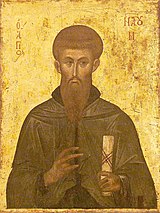Naum
Saint Naum , also called Naum Ohridski or Naum Preslawski ( Cyrillic Наум Охридски or Наум Преславски) lived at the turn of the 9th to 10th century (* around 830 ; † 910 , buried in the monastery Sveti Naum near Ohrid , North Macedonia) . He was a student of Saints Cyril and Method and, like them, participated in the creation of the Old Church Slavonic written language. Together with the holy Kliment of Ohrid , he was one of those monks who supported Methodius on his mission in the Great Moravian Empire .
- “... The honorable and great father Naum grew up in Moesia , and according to the upbringing his noble parents gave him, he considered nobility and wealth and all that for chaff and joined the apostle-like Constantine the philosopher and his brother Method who wandered around and taught the Moesian and Dalmatian people, followed them everywhere, even as far as ancient Rome ... "
In 874, the Moravian prince Kocel changed his political orientation, turned away from Constantinople and sought contacts to the west. Naum and the other students of Constantine and Method came into conflict with the Latin missionaries who came to Moravia and preferred to preach in Latin (and not in Slavic). After Method 885's death, his students were expelled and found refuge in the Bulgarian Empire of Tsar Boris I.
In order to push back the Byzantine influence on his state, Boris I was interested in the establishment of the Slavic language in worship. Two famous schools were founded under Kliments and Naum's leadership - the school in Ohrid , where Kliment worked, and the school in Preslaw , where Naum first worked (hence his nickname Preslawski). Old Church Slavonic was taught as the liturgical language in the two schools .
Towards the end of the 9th century, Saint Naum worked together with the holy Kliment von Ohrid from the Tsars Boris I and Simeon I in the Ohrid region.
- “... Naum and Kliment came to the Illyrian and Lychnidian lands. In the Dewol Mountains at the end of the lake of the city of Ochrida, between the rivers, Naum founded a large monastery and a church, dedicated to the Archangel Michael and all heavenly powers, with the means and at the behest of the pious Bulgarian Tsar Mikhail Boris and his son Tsar Simeon ... "
In addition to building churches and monasteries, both saints devoted themselves to the training of Slavic clerics and developed an ecclesiastical and cultural center from Ohrid. The Ohrid School produced a large part of the ancient Bulgarian literature.
Naum died in 910 and was buried in the Sveti Naum monastery, which he founded in 895 and is now located in North Macedonia , not far from the border with Albania .
Naum is venerated today as the "Illuminator of the Bulgarians" and as a saint of the Bulgarian Orthodox Church . Remembrance day is December 23rd / January 5th. Naum is also commemorated on July 27th, the day of the "Seven Saints" ("Свети седмочисленици", Kyrill, Method and their five students Kliment, Naum, Sava, Gorazd and Angelarij).
In his honor, St. Naum Peak on Livingston Island in Antarctica bears his name.
literature
- Hans-Dieter Döpmann : Church in Bulgaria from the beginnings to the present , Biblion Verlag, Munich 2006, ISBN 3-932331-90-7 .
- Cvetan Grozdanov: Sveti Naum Ohridski . Skopje 1995, ISBN 9989-30024-0 .
- Hans-Jochim Härtel, Roland Schönfeld: Bulgaria . Verlag Friedrich Pustet, Regensburg 1998, ISBN 3-7917-1540-2 .
- Edgar Hösch , Karl Nehring, Holm Sundhaussen (ed.): Lexicon for the history of Southeast Europe . Vienna / Cologne / Weimar 2004, ISBN 3-205-77193-1 .
- Frank Kämper: Naum , in: Biographical Lexicon for the History of Southeast Europe . Vol. 3. Munich 1979, p. 295 f.
- Dimiter Kossew (ed.), Woin Boshinow (ed.), Ljubomir Panajotow (ed.): Macedonia - a collection of documents . Bulgarian Academy of Sciences, Sofia 1982.
- Wolf Oschlies: Naum from Ohrid. In: Biographisch-Bibliographisches Kirchenlexikon (BBKL). Volume 32, Bautz, Nordhausen 2011, ISBN 978-3-88309-615-5 , Sp. 995-1014.
Web links
Individual evidence
- ↑ a b c Härtel, Schönfeld, pp. 30–33
- ↑ a b Excerpt from the "Life of Naum" ( "Житие на св. Наум" ) written in the 10th century by a student of Naum from Devoll , whose name has remained unknown. An Old Slavic copy of the book was discovered in 1906 in the Zografou monastery . There are also three Greek translations from the years 1695, 1740 and 1742, but they are shortened and little biographical material about Naum included (secondary sources: Kossew, Boshinow, Panayotov, 1982 and Васил Златарски, История на българската държава през средните векове , band I., Part 2., Sofia, 1971 and Trapp, E. The Vites of St. Naum von Ochrid , In: Byzantinoslavica , 35, 1974, pp. 161–185 and П. Лавров: Жития св. Наума Охридского и служба ему , In: Известия отделения русского языка и словесности Академии наук, XII., 4., 1907, pp. 1–51).
- ↑ a b Lexicon of the Middle Ages, p. 1378 "... the holy Clements of Ohrid and Naum, who were sent there on mission by the Bulgarian Prince Boris I and his successor Simeon, worked in the Ohrid region."
- ↑ Hösch / Nehring / Sundhaussen, 2004, p. 485.
- ↑ The exact day should be December 23 (see Trapp, Byzantinoslavica, XXXV., 1974, p. 166).
- ↑ Naum von Ochrid in the Ecumenical Lexicon of Saints , accessed on December 13, 2010
- ↑ Döpmann, 2006, pp. 24-25
| personal data | |
|---|---|
| SURNAME | Naum |
| ALTERNATIVE NAMES | Naum Ohridski; Naum Preslawski |
| BRIEF DESCRIPTION | Founder of the monastery and pupil of Saints Cyril and Methodius |
| DATE OF BIRTH | 9th century |
| DATE OF DEATH | 910 |
| Place of death | buried monastery Sveti Naum near Ohrid , Macedonia |
